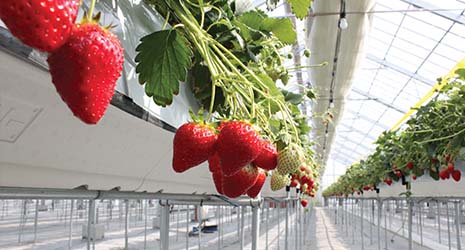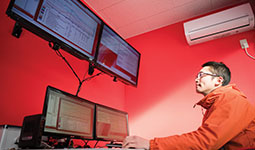Home > Highlighting JAPAN > Highlighting Japan May 2018 > Food and Agriculture Marketplace Potential
Highlighting JAPAN


Technology and Strawberries
A town recovering from the 2011 earthquake is using digitalization and visualization to produce its own premium brand of strawberries.
THE Great East Japan Earthquake and accompanying tsunami wreaked catastrophic damage on 90 percent of the strawberry-growing greenhouses in the town of Yamamoto, Miyagi Prefecture. Starting in 2011, however, an agricultural production corporation called GRA Inc. used information and communications technology (ICT) to build a viable strawberry-growing system from scratch in just a single year. The CEO of GRA Hiroki Iwasa—a Yamamoto native who was managing an IT company in Tokyo at the time— decided to step in to help revive the area’s local businesses. Iwasa became the main driver behind bringing a new life and purpose to strawberry producers in his disaster-stricken hometown.
“By systematically digitalizing the plastic greenhouse environment and the yield and condition of the plants, and then comparing the data, we were able to see the causal relationships that resulted in poor cultivation,” says Wataru Sugeno, GRA’s researcher. “Before this, digitalization was never applied; everything relied on the experience of veteran workers and intuition. That makes it hard to start a new business or achieve industrial progress, and takes too much time to recover. Using the PDCA cycle in the agricultural business can bring continuous improvements and help create an ideal growing environment.”
GRA devised a plan to completely digitalize the process using ICT. Their yield was low the first year because they couldn’t harvest samples in sufficient volume. The database they built, however, helped pinpoint measures for improvement, and they found their groove in year two.
“GRA also uses automated systems inside the greenhouse to regulate things like temperature, humidity, solar radiation, carbon dioxide concentration and other environmental aspects that are clearly more effective than relying on human experience and intuition alone,” Sugeno says. “Since we can get very close to a designed environment, we can move forward at an accelerated pace even without having much experience. Data can be monitored practically in real time, and uploaded to the cloud to be shared with any location. That’s one huge benefit of applying IT.”
The system has enabled GRA to supply a stable crop of strawberries with high sugar content and striking appearance. Their three superior varieties—produced based on the concept that “if you polish it, it will shine”—are sold under the unified brand name Migaki Ichigo (“polished strawberries”). Migaki Ichigo has become a representative brand for Yamamoto, boasting exclusive sales deals at famous Tokyo department stores, and is exported overseas as a premium strawberry brand.
On the other hand, it’s difficult to determine certain benchmarks and indices in the agriculture business without the knowledge of veteran farmers. That’s why GRA is digitalizing the intuition cultivated by farmers with years of experience to visualize of their expertise.
“It’s easier to get into the industry,” Sugeno says, “when things that only veteran farmers understand become clear. Visualization is also assisting in the training of a new generation of agricultural workers.”
Between FY2012 and 2017, GRA conducted a wide range of research as part of a research project sponsored by Japan’s Reconstruction Agency and the Ministry of Agriculture, Forestry and Fisheries. Even while he engaged in demonstrating never-before-seen technologies, Sugeno was seeking countermeasures against crop diseases, and was able to construct an ideal environment for strawberry cultivation.
Damage from the earthquake and tsunami had also made it impossible to properly cultivate the soil in Yamamoto, so GRA adopted a nutriculture method that employs coconut shells. Their production method—largely free of the influence of climate and soil—takes full advantage of the environmental control capabilities unique to greenhouses. The company is also deploying workers to other areas to grow Migaki Ichigo in Aichi and Kanagawa, and began cultivation in India in 2012. There are great expectations for the part that ICT will play in the future of global agriculture.
© 2009 Cabinet Office, Government of Japan








